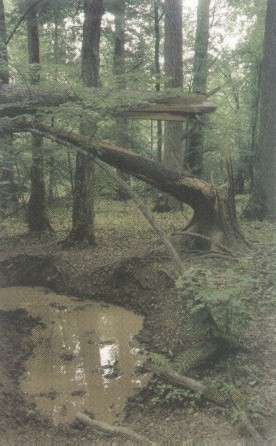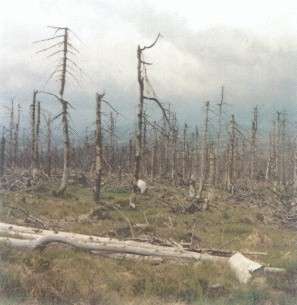The Condition of Forests
![]()
 Each month measurements
of the content of sulphur dioxide, nitrogen oxides and dust in
the air are taken. The accumulation of pollution in the form of
dry deposits is measured. On the basis of these reports scientists
delineated zones where forests are endangered by industrial ambient
air pollutants (MAPS illustrating the index
of dry deposit of SO2 and NOx). The
tHReat posed by deposits of sulphur is confirmed by measurements
of its content in pine needles (MAP illustrating
the amount of sulphur in pine tree needles). Evaluations of
the degree of needle and leaf loss and the overcolouration of
tree crowns show that in 1995 merely 5.7% of the forests could
be considered undamaged, while 41.6% were considered to be tHReatened.
Light and medium damage was sustained by 49.5% of the trees in
Poland, 3.2% of the trees were badly damaged and withering away.
The worst damage was sustained by forests in the following voivodships:
Katowice, Krosno, Wroclaw, Cracow and Gdansk, while the least
damage was suffered by trees in the Bialystok, Lublin and Warsaw
voivodships.
Each month measurements
of the content of sulphur dioxide, nitrogen oxides and dust in
the air are taken. The accumulation of pollution in the form of
dry deposits is measured. On the basis of these reports scientists
delineated zones where forests are endangered by industrial ambient
air pollutants (MAPS illustrating the index
of dry deposit of SO2 and NOx). The
tHReat posed by deposits of sulphur is confirmed by measurements
of its content in pine needles (MAP illustrating
the amount of sulphur in pine tree needles). Evaluations of
the degree of needle and leaf loss and the overcolouration of
tree crowns show that in 1995 merely 5.7% of the forests could
be considered undamaged, while 41.6% were considered to be tHReatened.
Light and medium damage was sustained by 49.5% of the trees in
Poland, 3.2% of the trees were badly damaged and withering away.
The worst damage was sustained by forests in the following voivodships:
Katowice, Krosno, Wroclaw, Cracow and Gdansk, while the least
damage was suffered by trees in the Bialystok, Lublin and Warsaw
voivodships.
The condition of forests in Poland has been constantly
degrading for the last tHRee years (GRAPH
illustrating the damage to forests). The most endangered species
is the fir tree. It is already extinct in the Sudeten Mountains,
the western part of the Carpathian Mountains and in Silesia. Fir
trees are dying in Swietokrzyskie Mountains in Puszcza Jodlowa
and in Bieszczady Mountains. All indications are that the fate
of fir trees will be the same as the stone pine and yew. They
will become a relict in the forests. Pine trees and spruce are
also tHReatened. Mountainous terrain is where destructive processes
are most prevalent. The dieback of spruce tree stands in the Sudeten
Mountains, Beskid Slaski and Beskid Zywiecki is becoming an ecological
disaster. In the upper subalpine forest trees of all ages are
dying. 92.7% of the coniferous tree stands in Wroclaw  voivodship is damaged as well
as is 88.6% of Katowice voivodship and 81.3% of Cracow voivodship.
The entire Kraina Sudecka has only 1.8% of forests healthy. Up
till now about 13,500 ha of forests withered away. About 3,600
ha of terrain over the altitude of 800 m remains deforested despite
the attempts at reforestation; plant succession has retreated
grasses. The dieback process in mountain forests is moving east
and into the valleys, affecting areas such as Gory Kamienne and
Gory Walbrzyskie as well as Gory Bystrzyckie and Gory Stolowe.
voivodship is damaged as well
as is 88.6% of Katowice voivodship and 81.3% of Cracow voivodship.
The entire Kraina Sudecka has only 1.8% of forests healthy. Up
till now about 13,500 ha of forests withered away. About 3,600
ha of terrain over the altitude of 800 m remains deforested despite
the attempts at reforestation; plant succession has retreated
grasses. The dieback process in mountain forests is moving east
and into the valleys, affecting areas such as Gory Kamienne and
Gory Walbrzyskie as well as Gory Bystrzyckie and Gory Stolowe.
Deforestation of watersheds and mountain catchments may cause very painful and wide ranging natural, societal and ecological consequences. If the forests wither away, all other efforts to protect the natural environment will not make sense any more.
A "chain sickness" model has been used up till now to explain the course of forest diseases. It presented an ordered sequence of consecutive cause and effect relationships. Particular links in this chain were easy to define and set apart. The death of a tree or a tree stand was the final outcome of a chain sickness. It did not preclude the possibility of replanting the forest. Now the chain sickness model is not sufficient to explain the phenomena that are shaping the condition of forests. A characteristic feature of new tHReats is the impossibility or difficulty in pointing out just one, or the most important cause, of the disease. It is rather a general weakening or loss of biological resistance, as a result of unfavourable environment change. These changes culminate in attacks by organisms that in normal conditions would have no effect on the health of trees. This is why the nature of the new category of tHReats does not lie in the increased mortality of trees, as was the case until now with climatic disasters, insect gradations or fungal diseases. In regions of the largest damage ecosystems are falling apart and this forest creating processes have stopped, which results in the gradual elimination of forest as a plant formation. In place of forests, new organism groupings arise and grass and brushwood grow.